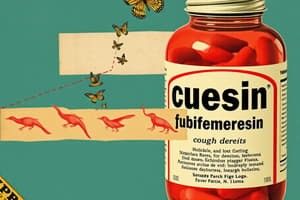Podcast
Questions and Answers
Which pharmacological action primarily explains how expectorants like guaifenesin facilitate mucus removal?
Which pharmacological action primarily explains how expectorants like guaifenesin facilitate mucus removal?
- Dilating the bronchioles to allow for greater airflow and expulsion of mucus.
- Strengthening the cough reflex to enhance clearance of secretions.
- Increasing the viscosity of the mucus for easier expectoration.
- Reducing the surface tension of secretions to thin thick mucus. (correct)
A client taking guaifenesin reports feeling dizzy. What intervention should the nurse prioritize?
A client taking guaifenesin reports feeling dizzy. What intervention should the nurse prioritize?
- Instructing the client to ambulate frequently to improve circulation.
- Administering an antiemetic to prevent nausea.
- Withholding the next dose of guaifenesin and consulting the provider.
- Monitoring the client during position changes to prevent falls. (correct)
A client on sustained-release guaifenesin complains of difficulty swallowing the tablet. Which action is most appropriate?
A client on sustained-release guaifenesin complains of difficulty swallowing the tablet. Which action is most appropriate?
- Breaking the tablet in half for easier administration.
- Advising the client to chew the tablet thoroughly before swallowing.
- Contacting the provider for an alternative form of the medication. (correct)
- Crushing the tablet and mixing it with applesauce for easier swallowing.
A client with a persistent cough and thick mucus is prescribed guaifenesin. What client education should be included regarding fluid intake?
A client with a persistent cough and thick mucus is prescribed guaifenesin. What client education should be included regarding fluid intake?
A client taking an expectorant develops a high fever and worsening cough. What action should the client be instructed to take?
A client taking an expectorant develops a high fever and worsening cough. What action should the client be instructed to take?
Which condition would be a contraindication for using expectorants containing aspartame?
Which condition would be a contraindication for using expectorants containing aspartame?
A client reports gastrointestinal distress after starting guaifenesin. What recommendation should the healthcare provider offer?
A client reports gastrointestinal distress after starting guaifenesin. What recommendation should the healthcare provider offer?
Why should expectorants be given only when needed and not in combination products for colds that also contain guaifenesin?
Why should expectorants be given only when needed and not in combination products for colds that also contain guaifenesin?
Flashcards
Expectorants
Expectorants
Medications used to treat colds and upper respiratory infections by helping to remove mucus.
Expectorant Action
Expectorant Action
Reduces the surface tension of secretions, thinning thick mucus for easier removal.
Expectorant Side Effects
Expectorant Side Effects
Dizziness, drowsiness, nausea, diarrhea, and allergic reactions (rash).
Expectorant Interventions
Expectorant Interventions
Signup and view all the flashcards
Expectorant Administration
Expectorant Administration
Signup and view all the flashcards
Guaifenesin
Guaifenesin
Signup and view all the flashcards
Expectorant Instructions
Expectorant Instructions
Signup and view all the flashcards
Expectorant Contraindications
Expectorant Contraindications
Signup and view all the flashcards
Study Notes
- Expectorants treat colds and upper respiratory infections that produce mucus.
- They can also be administered for bronchitis to help remove secretions.
Prototype and Other Medications
- Guaifenesin is the prototype medication.
Expected Pharmacologic Action
- Expectorants reduce the surface tension of secretions.
- This thins thick mucus, making it easier to cough out of the lungs, nose, and sinuses.
Adverse Drug Reactions
- Expectorants can cause dizziness, drowsiness, or headache.
- Gastrointestinal distress, like nausea and diarrhea, may occur.
- An allergic reaction may present as a rash.
Interventions
- Monitor clients for dizziness or drowsiness when changing positions or ambulating.
- Administer with food or 8 oz of water to avoid gastrointestinal distress.
- Discontinue the medication immediately if an allergic reaction occurs, and request an alternative from the provider.
Administration
- Advise clients to increase fluid intake to help liquefy secretions.
- Notify the provider if a cough worsens or a high fever develops, which may indicate pneumonia.
- Administer only when needed, and not with combination products for colds that also contain guaifenesin.
- Guaifenesin is available in tablets and sustained-release formulations.
- Clients should not chew sustained-release tablets, and health care providers should not crush them.
Client Instructions
- If experiencing dizziness or drowsiness, avoid driving or activities requiring mental alertness.
- Sit or lie down to prevent injury from a fall if these side effects occur.
- Change positions slowly to minimize these side effects.
- Take the medication with food or 8 oz of water if gastrointestinal distress occurs.
- Discontinue use and seek medical care immediately for allergic reactions.
Contraindications and Precautions
- Contraindicated for clients with known sensitivity and phenylketonuria (due to aspartame content).
- Use cautiously in clients who have a cough lasting more than one week, diabetes (due to sugar content), or who are receiving disulfiram (due to alcohol content).
Interactions
- No significant medication-medication interactions have been determined with guaifenesin.
Studying That Suits You
Use AI to generate personalized quizzes and flashcards to suit your learning preferences.




